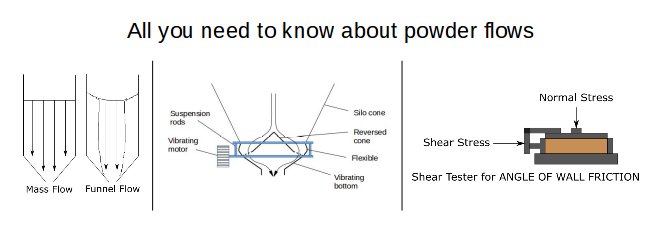
Solids properties & Solids flow
All you need to know about powder flow
Follow us on Twitter ![]()
Question, remark ? Contact us at admin@powderprocess.net
This index gives access to all the basics knowledge interesting for Process Engineers in the field of powder properties, powder flow, powder rheology, flowability of powder, flow properties of powder, silo design...

Powder / bulk solids properties and flowability
Powder properties
Learn about essential powder properties for industrial processes. From bulk density to cohesive strength, this page explains their importance and measurement methods. Discover the key to designing efficient hoppers and promoting solid flow. Explore the Jenike Method, shortcut methods, and electrostatic influences.
Silo Design and Calculation
Discover how to optimize powder handling processes and ensure efficient discharge. Learn about designing silos and hoppers, calculating critical parameters, and selecting discharging aids. Ensure reliable, controlled, and fast powder flow.
Silo volume calculation
Discover methods to accurately calculate the real volume of solids in hoppers and silos, essential for efficient inventory management. This page provides insights into conical hoppers, enabling precise design and capacity assessment. Explore a comprehensive guide to optimize your bulk solid storage and maintain inventory integrity.
How to solve flow problems in silos
Uncover the root causes of powder flow issues in hoppers and silos, and how to prevent and address them through effective design and discharging aids. Learn about bin activators, fluidizing pads, knockers, and more to ensure smooth and uninterrupted bulk solid flow.
Mass flow and funnel flow silos
Discover the difference between mass flow and funnel flow silos, with insights into their advantages and disadvantages. Learn how to select the right design based on your material's properties and processing needs. Ensure you understand the importance of regular silo inspection and maintenance for both types.
Sugar Silo : solving and preventing flow problems
Learn about the challenges of storing crystal sugar in large silos and how to prevent lumping and flow issues. Understand the root causes of sugar lumping, such as humidity and silo flow patterns. Explore practical solutions, including air conditioning, silo insulation, and optimizing flow patterns. Additionally, discover the importance of assessing dust explosion risks in sugar silos for safe and reliable production.
Hopper
and silos discharge rate calculation

Learn how to calculate hopper discharge flow rates for bulk solids, a critical task for process engineers. Explore two calculation methods: one using shear cells data and another based on empirical equations. Understand the formulas for both coarse and fine powders, along with the Janssen equation to calculate major consolidation stress. Additionally, discover an Excel calculation tool for estimating bulk discharge rates.
Arches
and ratholes
Learn about powder blockages in silos and hoppers. Discover the reasons behind arching and ratholing, and how to prevent them. Understand the forces that affect flowability and the role of outlet shape and hopper design. Find solutions, including discharging aids, to ensure smooth material flow in your storage systems.
Particle density
Apparent particle density definition and measurement
Bulk density
Bulk particle density definition and measurement
Skeletal density
Skeletal density definition and measurement
PSD - Particle Size Distribution
Carr Index & Hausner Ratio
Learn how to assess powder flowability using the Carr Index and Hausner Ratio. These indicators help you understand how bulk solids flow, crucial for design and troubleshooting. Calculate these ratios with simple formulas and interpret the results to determine flowability. Access a free Excel calculator for quick calculations.
Angle of repose
Explore the angle of repose, a key indicator of granular material flowability. Learn why it matters and how to calculate it using different methods. Understand that measurement protocols affect the results and discover the angle of repose's significance in assessing flowability. Access a free Excel calculator for quick angle of repose calculations.
Powder Rheometer
Discover the world of powder rheometers, like the Freeman FT4, for quick flowability data on powders. Learn their working principles, how to measure flowability, and interpret the results. See how these rheometers play a vital role in assessing material behavior in various processes, including dense phase conveying.
Static electricity influence on powder flow
Learn how electrostatic charges can impact powder flowability, causing issues like segregation and powder build-up. This page explores the root causes of electrostatic phenomena in powder handling and offers solutions to these challenges, enhancing your understanding of industrial processes.
Water activity
Understand the concept of water activity (aw) and its importance in various industries. Learn how to calculate water activity, measure it, and its impact on the flowability of bulk solids. Explore the role of water activity in food preservation and safety.
Moisture content
Learn about moisture content, its definition, calculation, and measurement. Discover the impact of moisture content on the flowability of powders and its significance in various engineering processes. Explore emerging technologies for precise moisture content measurement, improving efficiency and product quality.
Aeration / Fluidization / Permeability
Discover how aeration affects powder behavior and learn about classifying powders based on their aeration behavior. Explore Geldart's classification system and understand the relationship between aeration and powder flowability. Also, gain insights into the permeability of powders and how it impacts their behavior in various processes, including pneumatic conveying and fluidized beds.
Shear Cells Testing : Step by Step guide
Learn step by step how to determine powder flow characteristics through shear cell experiments. Understand key properties such as angle of internal friction, powder flow function, and angle of wall friction. This guide will help you design hoppers for optimal powder flow in various applications.
Pressure
profiles inside silos
Learn about the pressure profiles within bulk solids silos, from static conditions to discharge. Understand the distinctions between vertical and wall pressure, critical for silo design to ensure structural integrity and safety. Explore simplified models and equations to gain insights, but always consult specialized experts and standards for precise silo design.